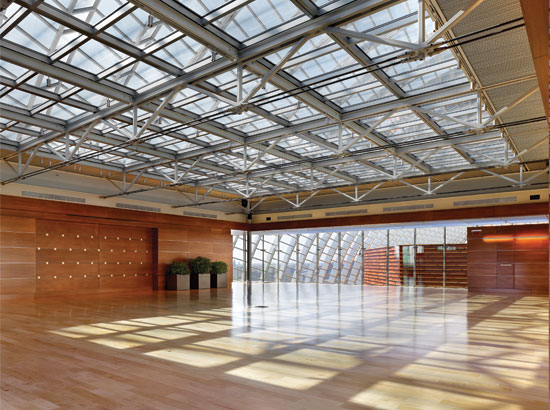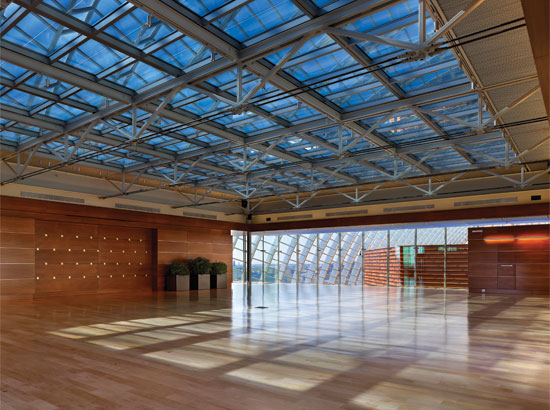Dynamic Solar Control with Electrochromic Glazing
Commonly, the higher percentage of VLT in glazing, the higher the value of SHGC, or simply put, more light usually means more heat. Conversely, lower VLT reduces solar heat gain, but it also restricts natural daylighting. When using static glazing, the designer needs to determine the most appropriate values for each of these two characteristics and then they stay that way for the life of the glazing.
With dynamic EC glazing, both of the values are variable and adjustable on demand, meaning that the building can respond to different conditions—relieving the designer from having to select only one set of ideal values. As a practical matter, however, it should be pointed out that the variability is commonly controllable at four pre-set points—a low or dark setting at 2 percent VLT, two intermediate settings at approximately 6 percent and 20 percent VLT, and a high point of approximately 60 percent VLT. These settings preserve the view and connection to the outdoors that humans thrive on no matter the time of day or time of year. By adjusting to outdoor conditions, it reduces glare, discomfort, and fading that negate the human benefits of sunlight. It also optimizes energy use in the building by rejecting solar heat gain when it is not wanted, and allowing it in when it is desirable or acceptable.
Although electrochromic glazing is a unique technological innovation, it is a cost-effective solar control system. Installed projects have been shown to generate dramatic reductions in operating energy costs since the EC glazing effectively blocks or admits solar heat and light as needed, thus reducing energy demand for heating, cooling, and lighting. Adding to the effectiveness, some advanced electrochromic glazing products have SHGC values of 0.09 in a tinted state, which is approximately three times better than most commercial static glazings. Even in this state, the EC glass transmits 2 percent of visible light. EC is also very cost effective, and can be cost neutral when compared to traditional solar control solutions, such as the combination of low-e glass with blinds and sunshades. This improved performance can also reduce first costs related to energy systems in new construction as smaller HVAC systems can often be used.
 |
Reducing heat gain and energy use in a public space with a skylight becomes very manageable using EC glazing, which is shown in its normal clear state (top image) and dynamically tinted (bottom image). Photos courtesy of SAGE Electrochromics, Inc. |
Regarding the operation of the EC glazing it should be stressed that due to its electronic nature, it uses minimal electricity. To put things in context, 2,000 square feet of EC glazing (approximately 100 windows) has been shown to be controllable using less power per day than one 60-watt light bulb. Hence, in exchange for a very minimal energy use, much more energy use can be offset and large potential net savings realized. Photovoltaic (PV) solar cells could also be a source of that energy. Because of their low DC voltage and power consumption, and the complementary relationship between the amount of sunlight available and the level of tinting required, EC glazing is an excellent candidate for PV power.
The overall energy results of a properly installed EC glazing system installed in a typical building are realized in several ways. First, it has been demonstrated to reduce overall energy loads (heating, cooling, and lighting) by up to 20 percent by controlling the daylight and solar heat gains of a building. The U.S. Department of Energy (DOE) is even more optimistic in its estimate that electronically tintable window systems are capable of providing up to 40 percent savings on energy bills and 20 percent on operating costs. Secondly, EC glazing can have a ripple effect by lowering peak electrical demand power requirements by up to 30 percent, saving some building owners a considerable amount of money beyond pure consumption costs. Thirdly, when used as part of an effective overall daylighting strategy, it can lower electrical lighting costs by up to 60 percent. Finally, all of those load reductions conclude that EC glazing can reduce HVAC equipment sizing by up to 25 percent compared to conventional building designs.
Looking at the bigger picture of energy consumption and CO2 emissions, utility companies commonly run their most efficient power plants to meet base load demand and slowly bring on less efficient, more CO2 emitting plants as demand increases. The increased electricity demands are most common during hot weather periods with abundant sunshine. Electrochromic glazing reduces the building loads during these peak utility times, thus directly contributing to reducing power plant emissions. In full building installations, electrochromic glazing can reduce peak load carbon emissions by as much as 35 percent in new construction and 50 percent in renovation projects.
Sustainability Factors:Living with EC Glazing
In addition to energy savings through solar heat gain management, electrochromic glazing contributes to an energy-efficient, sustainable building in several other important ways as discussed further.
 |
|
The comfort and ambience of this restaurant space with EC glazing can be more desirable than rooms with adjustable interior blinds. Photo courtesy of SAGE Electrochromics, Inc. |










